
Sagar Bashyal
@sagarbashyal.bsky.social
PhD candidate
Salk Institute | University of California SanDiego
AM symbiosis and anything related MPMI✌️
Mueller Lab🍀
https://mueller.salk.edu/people/
Salk Institute | University of California SanDiego
AM symbiosis and anything related MPMI✌️
Mueller Lab🍀
https://mueller.salk.edu/people/
Pinned
Sagar Bashyal
@sagarbashyal.bsky.social
· Apr 15
Absolutely thrilled to share our story—please take a moment to check it out! Huge thanks to all the contributors and my amazing supervisor @lmueller.bsky.social . This was truly a team effort! #peptides #mycorrhiza
www.pnas.org/doi/10.1073/...
www.pnas.org/doi/10.1073/...
Reposted by Sagar Bashyal
SALICYLIC ACID SENSOR1 reveals the propagation of an SA hormone surge during plant pathogen advance
www.science.org/doi/10.1126/...
www.science.org/doi/10.1126/...

SALICYLIC ACID SENSOR1 reveals the propagation of an SA hormone surge during plant pathogen advance
Salicylic acid (SA) is a key phytohormone that orchestrates immune responses against pathogens, including Pseudomonas syringae bacteria. The timing and extent of SA accumulation are tightly controlled...
www.science.org
October 10, 2025 at 12:46 PM
SALICYLIC ACID SENSOR1 reveals the propagation of an SA hormone surge during plant pathogen advance
www.science.org/doi/10.1126/...
www.science.org/doi/10.1126/...
Grateful to be honored with the Alstroemeria Award from @ucsandiego.bsky.social
🌸. This recognition would not have been possible without the incredible support from so many people behind the scenes, thank you for lifting me up along the way. @salkinstitute.bsky.social
🌸. This recognition would not have been possible without the incredible support from so many people behind the scenes, thank you for lifting me up along the way. @salkinstitute.bsky.social

September 26, 2025 at 4:48 PM
Grateful to be honored with the Alstroemeria Award from @ucsandiego.bsky.social
🌸. This recognition would not have been possible without the incredible support from so many people behind the scenes, thank you for lifting me up along the way. @salkinstitute.bsky.social
🌸. This recognition would not have been possible without the incredible support from so many people behind the scenes, thank you for lifting me up along the way. @salkinstitute.bsky.social
Reposted by Sagar Bashyal
The lab is moving to the Salk Institute! We are thrilled to join an inspiring community where we will continue to explore plant growth and development.
Deep gratitude for the years of support and collaboration at Duke/NCSU/UNC.
www.salk.edu/news-release...
Deep gratitude for the years of support and collaboration at Duke/NCSU/UNC.
www.salk.edu/news-release...

Plant biologist Lucia Strader joins Salk faculty to study plant growth signaling - Salk Institute for Biological Studies
LA JOLLA—The Salk Institute will welcome plant biologist Lucia Strader as a new professor and holder of the Howard H. and Maryam R. Newman Chair in Plant Biology in October 2025. Strader is an interna...
www.salk.edu
August 25, 2025 at 6:44 PM
The lab is moving to the Salk Institute! We are thrilled to join an inspiring community where we will continue to explore plant growth and development.
Deep gratitude for the years of support and collaboration at Duke/NCSU/UNC.
www.salk.edu/news-release...
Deep gratitude for the years of support and collaboration at Duke/NCSU/UNC.
www.salk.edu/news-release...
Reposted by Sagar Bashyal
Thrilled to have our spatial single-cell atlas of the Arabidopsis lifecycle in @NaturePlants. Turns out that its easy to make nice images when spatial expression of 1,000 genes is available! 1/n
@natanellae.bsky.social @tatsuyanobori.bsky.social @joeecker.bsky.social
www.nature.com/articles/s41...
@natanellae.bsky.social @tatsuyanobori.bsky.social @joeecker.bsky.social
www.nature.com/articles/s41...
August 19, 2025 at 9:17 AM
Thrilled to have our spatial single-cell atlas of the Arabidopsis lifecycle in @NaturePlants. Turns out that its easy to make nice images when spatial expression of 1,000 genes is available! 1/n
@natanellae.bsky.social @tatsuyanobori.bsky.social @joeecker.bsky.social
www.nature.com/articles/s41...
@natanellae.bsky.social @tatsuyanobori.bsky.social @joeecker.bsky.social
www.nature.com/articles/s41...
Reposted by Sagar Bashyal
I am thrilled to share the 2nd chapter of my PhD with @adsteinbrenner.bsky.social In collaboration with @tiszapatrick we demonstrated that the LRR-RLP INR is the missing molecular link between caterpillar recognition and predatory wasp recruitment in the field. A thread 1/6
A plant immune receptor mediates tritrophic interactions by linking caterpillar detection to predator recruitment https://www.biorxiv.org/content/10.1101/2025.07.29.667524v1
August 1, 2025 at 9:25 PM
I am thrilled to share the 2nd chapter of my PhD with @adsteinbrenner.bsky.social In collaboration with @tiszapatrick we demonstrated that the LRR-RLP INR is the missing molecular link between caterpillar recognition and predatory wasp recruitment in the field. A thread 1/6
Reposted by Sagar Bashyal
Excited this paper is finally published! We focused on the inner concave surface of LRR RKs to expand bacterial flagellin perception in plants. Selection indicates expanded perception is more common than previously thought. Experiments led by @jerrytli.bsky.social www.nature.com/articles/s41...
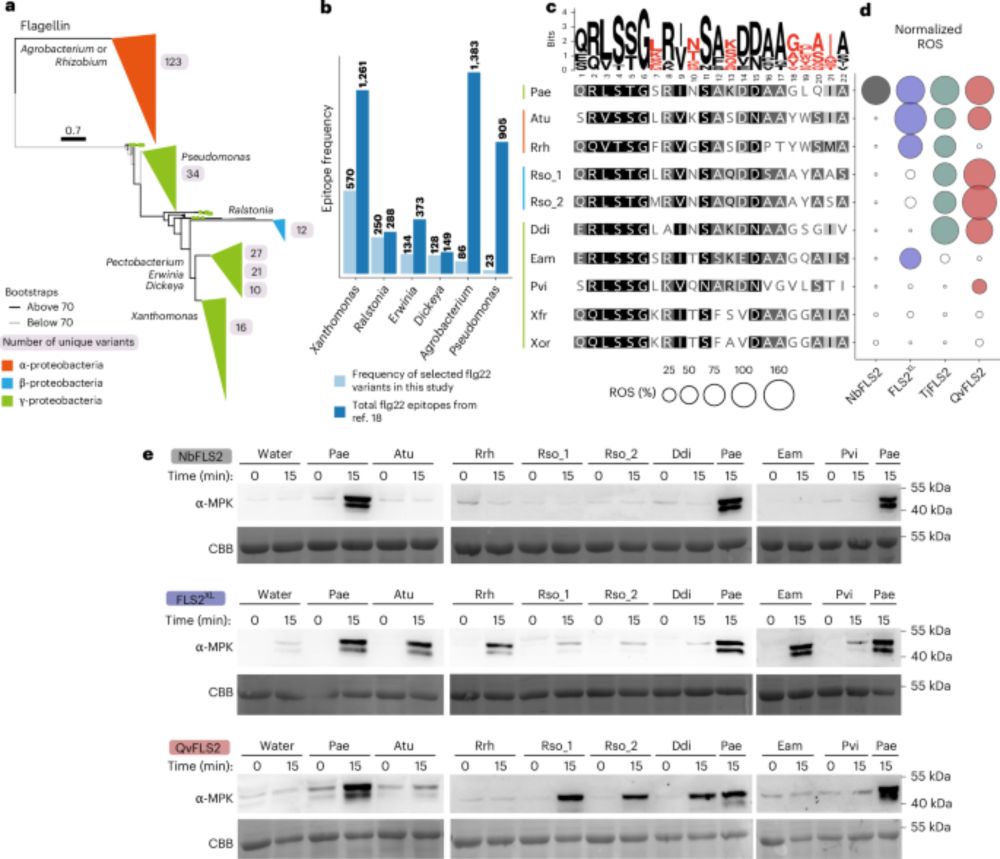
Unlocking expanded flagellin perception through rational receptor engineering - Nature Plants
Receptor kinase FLS2 detects the flg22 epitope of bacterial flagellin. Here the authors identify key residues on FLS2’s concave surface that enable expanded perception of flg22 variants, allowing the ...
www.nature.com
July 29, 2025 at 1:18 AM
Excited this paper is finally published! We focused on the inner concave surface of LRR RKs to expand bacterial flagellin perception in plants. Selection indicates expanded perception is more common than previously thought. Experiments led by @jerrytli.bsky.social www.nature.com/articles/s41...
Grateful to be at #2025ISMPMI! Reconnected with my former mentor @carogutj.bsky.social and met Maria, my current PIs mentor-so many cool stories🌱
Loved the energy at the poster session and great chats, including with Ertao Wang whose AMF work continues to inspire. #AMF
Loved the energy at the poster session and great chats, including with Ertao Wang whose AMF work continues to inspire. #AMF
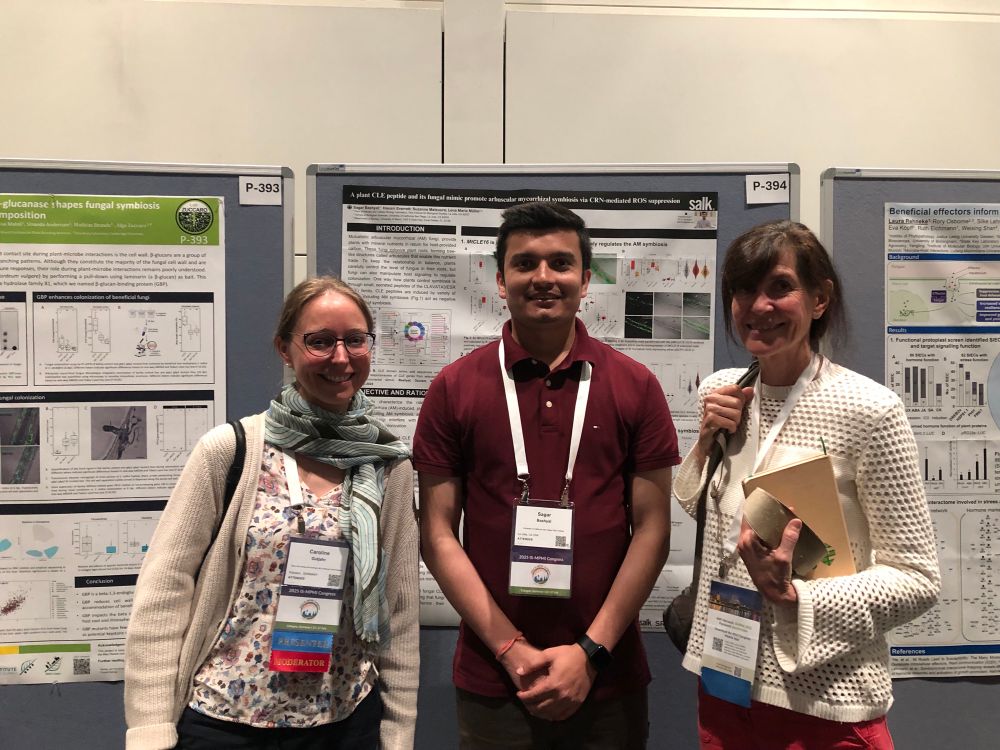

July 15, 2025 at 5:05 PM
Grateful to be at #2025ISMPMI! Reconnected with my former mentor @carogutj.bsky.social and met Maria, my current PIs mentor-so many cool stories🌱
Loved the energy at the poster session and great chats, including with Ertao Wang whose AMF work continues to inspire. #AMF
Loved the energy at the poster session and great chats, including with Ertao Wang whose AMF work continues to inspire. #AMF
Reposted by Sagar Bashyal
Mark Estelle- UC San Diego- honored for his lifetime of excellence in research, mentorship, and support of the Arabidopsis community #ICAR2025
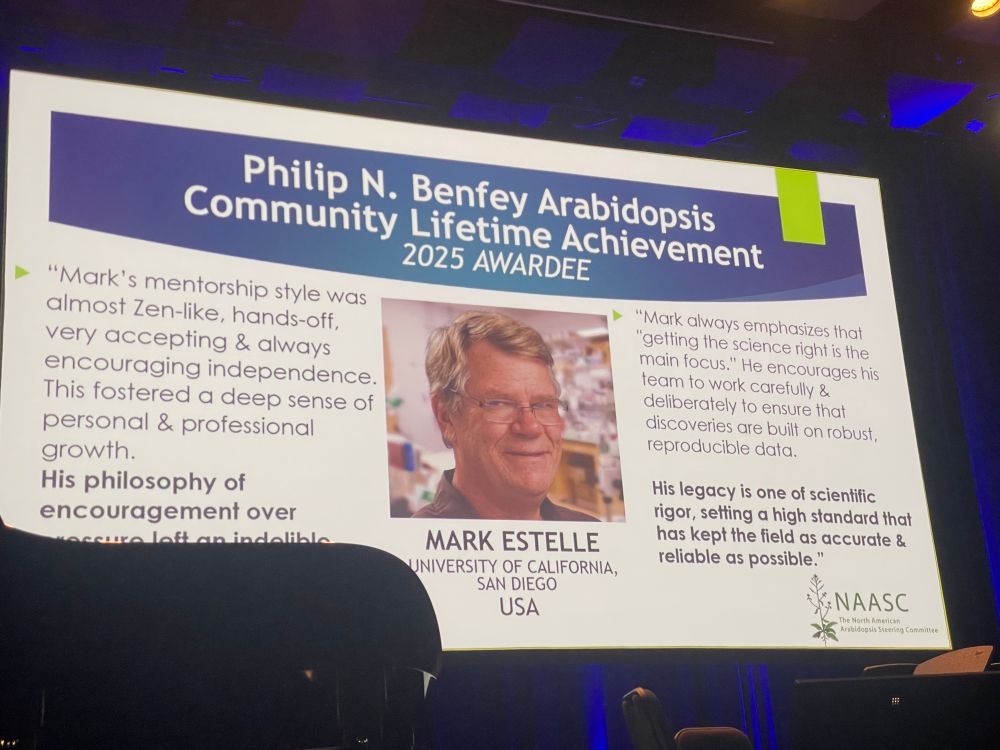
June 16, 2025 at 7:05 PM
Mark Estelle- UC San Diego- honored for his lifetime of excellence in research, mentorship, and support of the Arabidopsis community #ICAR2025
Reposted by Sagar Bashyal
The latest publication from our lab!
The famous "glomalin" from arbuscular mycorrhizal (AM) fungi is not a protein but a polysaccharide from AM fungi, so we renamed it "glomalose". Glomalin-related proteins are bacterial proteins stuck in this glomalose.
nph.onlinelibrary.wiley.com/doi/10.1111/...
The famous "glomalin" from arbuscular mycorrhizal (AM) fungi is not a protein but a polysaccharide from AM fungi, so we renamed it "glomalose". Glomalin-related proteins are bacterial proteins stuck in this glomalose.
nph.onlinelibrary.wiley.com/doi/10.1111/...
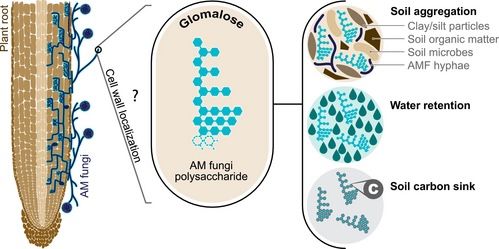
June 6, 2025 at 1:54 PM
The latest publication from our lab!
The famous "glomalin" from arbuscular mycorrhizal (AM) fungi is not a protein but a polysaccharide from AM fungi, so we renamed it "glomalose". Glomalin-related proteins are bacterial proteins stuck in this glomalose.
nph.onlinelibrary.wiley.com/doi/10.1111/...
The famous "glomalin" from arbuscular mycorrhizal (AM) fungi is not a protein but a polysaccharide from AM fungi, so we renamed it "glomalose". Glomalin-related proteins are bacterial proteins stuck in this glomalose.
nph.onlinelibrary.wiley.com/doi/10.1111/...
Reposted by Sagar Bashyal
Excited to share my new Tansley Review @newphyt.bsky.social on emerging single-cell and spatial omics technologies, many of which are just beginning to be applied in plant biology! Big opportunities lie ahead for the field. [1/n]
nph.onlinelibrary.wiley.com/doi/10.1111/...
nph.onlinelibrary.wiley.com/doi/10.1111/...
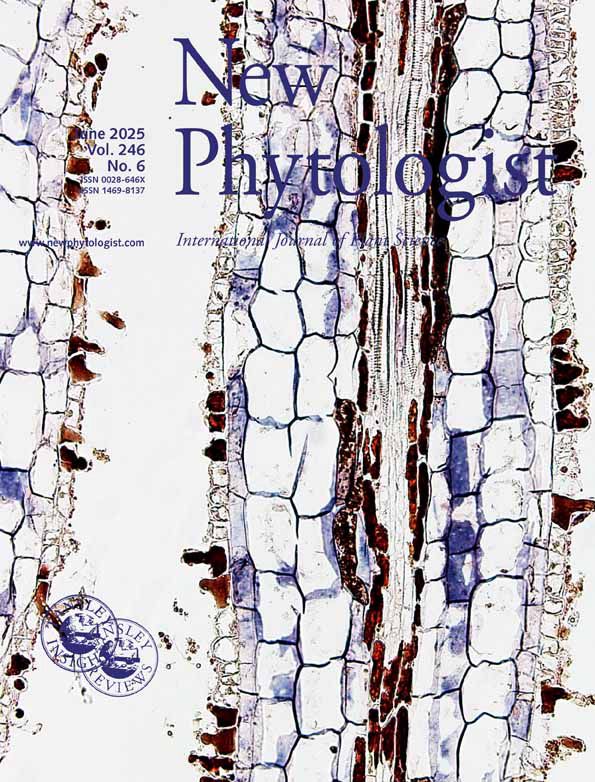
Exploring the untapped potential of single‐cell and spatial omics in plant biology
Advances in single-cell and spatial omics technologies have revolutionised biology by revealing the diverse molecular states of individual cells and their spatial organization within tissues. The fie...
nph.onlinelibrary.wiley.com
May 22, 2025 at 6:46 AM
Excited to share my new Tansley Review @newphyt.bsky.social on emerging single-cell and spatial omics technologies, many of which are just beginning to be applied in plant biology! Big opportunities lie ahead for the field. [1/n]
nph.onlinelibrary.wiley.com/doi/10.1111/...
nph.onlinelibrary.wiley.com/doi/10.1111/...
Reposted by Sagar Bashyal
Join us for the 🪴 🌵 Plant Peptide Receptor Meeting 2025 ☘️ 🪴 in 🏴 Edinburgh 🏴 8th-10th September
#plantsignaling #PlantScience #plantsci
pprm2025.events.kdmeventsportal.co.uk
@pprm2025.bsky.social
A thread 🧵
(1/n)
#plantsignaling #PlantScience #plantsci
pprm2025.events.kdmeventsportal.co.uk
@pprm2025.bsky.social
A thread 🧵
(1/n)

Plant Peptide Receptor Meeting 2025
pprm2025.events.kdmeventsportal.co.uk
May 20, 2025 at 2:44 PM
Join us for the 🪴 🌵 Plant Peptide Receptor Meeting 2025 ☘️ 🪴 in 🏴 Edinburgh 🏴 8th-10th September
#plantsignaling #PlantScience #plantsci
pprm2025.events.kdmeventsportal.co.uk
@pprm2025.bsky.social
A thread 🧵
(1/n)
#plantsignaling #PlantScience #plantsci
pprm2025.events.kdmeventsportal.co.uk
@pprm2025.bsky.social
A thread 🧵
(1/n)
Congratulations Michael and the entire team!👏Cool work from the @carogutj.bsky.social lab and a testament to all the long hard work behind it @pnas.org . Grateful to have contributed to this story✌️. Checkout the mechanisms by which the RAM1 functions.
www.pnas.org/doi/full/10....
www.pnas.org/doi/full/10....
PNAS
Proceedings of the National Academy of Sciences (PNAS), a peer reviewed journal of the National Academy of Sciences (NAS) - an authoritative source of high-impact, original research that broadly spans...
www.pnas.org
May 19, 2025 at 8:37 PM
Congratulations Michael and the entire team!👏Cool work from the @carogutj.bsky.social lab and a testament to all the long hard work behind it @pnas.org . Grateful to have contributed to this story✌️. Checkout the mechanisms by which the RAM1 functions.
www.pnas.org/doi/full/10....
www.pnas.org/doi/full/10....
Thank you☘️
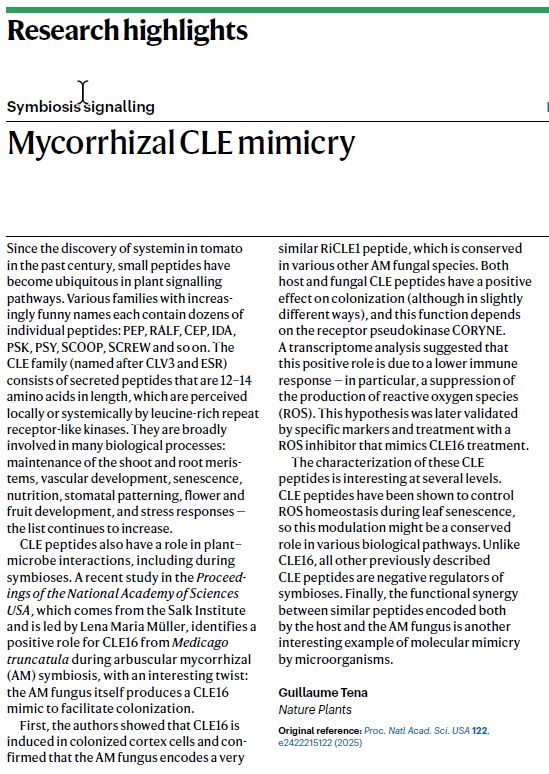
May 14, 2025 at 1:42 AM
Thank you☘️
Reposted by Sagar Bashyal

May 13, 2025 at 12:53 PM
Great to see our work highlighted in
@natplants.nature.com !🍀☘️🍄
Check it out: nature.com/articles/s41...
@lmueller.bsky.social @salkinstitute.bsky.social @ucsandiego.bsky.social
@natplants.nature.com !🍀☘️🍄
Check it out: nature.com/articles/s41...
@lmueller.bsky.social @salkinstitute.bsky.social @ucsandiego.bsky.social
Mycorrhizal CLE mimicry - Nature Plants
Nature Plants - Mycorrhizal CLE mimicry
nature.com
May 14, 2025 at 1:32 AM
Great to see our work highlighted in
@natplants.nature.com !🍀☘️🍄
Check it out: nature.com/articles/s41...
@lmueller.bsky.social @salkinstitute.bsky.social @ucsandiego.bsky.social
@natplants.nature.com !🍀☘️🍄
Check it out: nature.com/articles/s41...
@lmueller.bsky.social @salkinstitute.bsky.social @ucsandiego.bsky.social
Reposted by Sagar Bashyal
🌍 International Molecular Mycorrhiza Meeting 2025!
#IMMM2025
🏨 Book your hotel at our discounted group rate: genetik.bio.lmu.de/immm-2025/lo...
⚠️ Discounted rate only available until May 16th – act fast!
#IMMM2025
🏨 Book your hotel at our discounted group rate: genetik.bio.lmu.de/immm-2025/lo...
⚠️ Discounted rate only available until May 16th – act fast!
May 13, 2025 at 12:00 PM
🌍 International Molecular Mycorrhiza Meeting 2025!
#IMMM2025
🏨 Book your hotel at our discounted group rate: genetik.bio.lmu.de/immm-2025/lo...
⚠️ Discounted rate only available until May 16th – act fast!
#IMMM2025
🏨 Book your hotel at our discounted group rate: genetik.bio.lmu.de/immm-2025/lo...
⚠️ Discounted rate only available until May 16th – act fast!
Reposted by Sagar Bashyal
Great review from @lmueller.bsky.social -> Signaling peptides control beneficial and pathogenic plant-microbe interactions | Journal of Experimental Botany | Oxford Academic
Signaling peptides control beneficial and pathogenic plant-microbe interactions
Interactions between organisms, such as those between plants and microbes, require extensive signaling between and within each organism to detect and recognize the partner and elicit an appropriate response. Multiple families of small signaling peptides regulate plant interactions with beneficial or pathogenic microbes, and sometimes both. Some of these signaling peptides transmit information between different cells or organs of the host and allow plants to orchestrate a coordinated response towards microbial mutualists or pathogens. However, not only plants produce signaling peptides required for the interactions. Microbes themselves also secrete peptide signals, which are detected by host receptors and required for infection. Among these are microbial peptides mimicking those of plants, allowing mutualistic or pathogenic microbes to hijack endogenous plant signaling pathways and evade the host immune system. In this review, we provide a comprehensive summary of current knowledge on host- and microbe-derived signaling peptides and their cognate receptors regulating mutualistic and parasitic plant-microbe interactions. Furthermore, we describe how microbes hijack endogenous host signaling pathways, and discuss possible crosstalk between the plant signaling pathways controlling mutualism with those modulating immune responses to pathogens.
academic.oup.com
May 9, 2025 at 2:16 PM
Great review from @lmueller.bsky.social -> Signaling peptides control beneficial and pathogenic plant-microbe interactions | Journal of Experimental Botany | Oxford Academic
Reposted by Sagar Bashyal
Finally, I am thrilled to share our long-term volatile project is out in Plant Communications! 🥳
Bacterial community-emitted volatiles regulate Arabidopsis growth and root architecture in a distinct manner from those from individual strains: Plant Communications www.cell.com/plant-commun...
Bacterial community-emitted volatiles regulate Arabidopsis growth and root architecture in a distinct manner from those from individual strains: Plant Communications www.cell.com/plant-commun...

Bacterial community-emitted volatiles regulate Arabidopsis growth and root architecture in a distinct manner from those from individual strains
Short summary: This study reveals that the effects of bacterial community-produced
volatiles on Arabidopsis growth and root architecture are an emergent property beyond
the sum of effects by individua...
www.cell.com
May 7, 2025 at 11:51 AM
Finally, I am thrilled to share our long-term volatile project is out in Plant Communications! 🥳
Bacterial community-emitted volatiles regulate Arabidopsis growth and root architecture in a distinct manner from those from individual strains: Plant Communications www.cell.com/plant-commun...
Bacterial community-emitted volatiles regulate Arabidopsis growth and root architecture in a distinct manner from those from individual strains: Plant Communications www.cell.com/plant-commun...
Reposted by Sagar Bashyal
The second new paper from the Estelle lab out this week describes the phenotype of moss lines lacking all seven Class-A ARFs (Activating ARFs) and was lead former postdoc Carlisle Bascom, Jr.
academic.oup.com/jxb/advance-...
academic.oup.com/jxb/advance-...
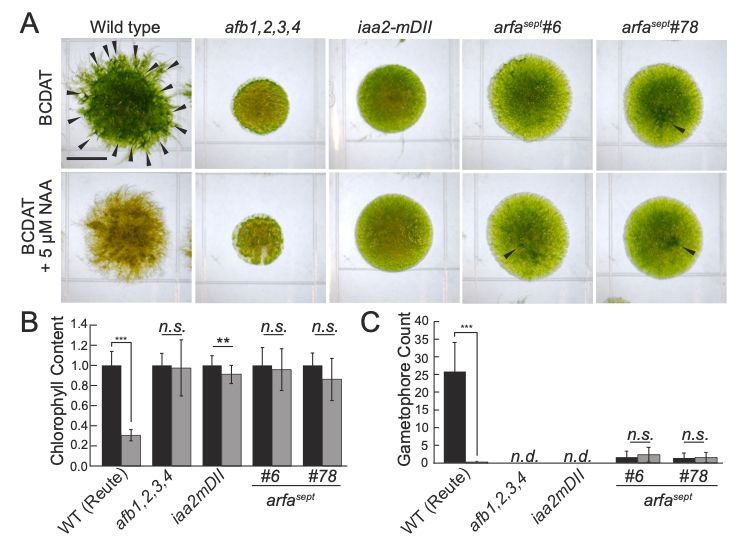
May 5, 2025 at 10:39 PM
The second new paper from the Estelle lab out this week describes the phenotype of moss lines lacking all seven Class-A ARFs (Activating ARFs) and was lead former postdoc Carlisle Bascom, Jr.
academic.oup.com/jxb/advance-...
academic.oup.com/jxb/advance-...
Reposted by Sagar Bashyal
We have a postdoc position that just opened up in the Brady lab on reprogramming tomato root system architecture in response to changes in nutrient availability - please consider applying! recruit.ucdavis.edu/JPF07095
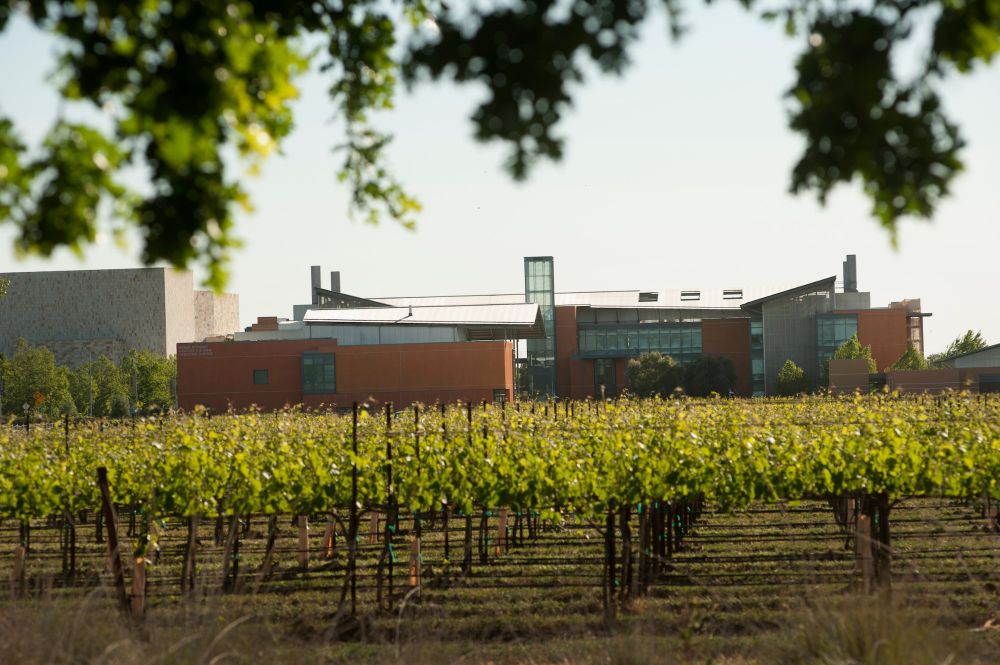
Postdoctoral Researcher- Brady Lab
University of California, Davis is hiring. Apply now!
recruit.ucdavis.edu
April 19, 2025 at 2:15 PM
We have a postdoc position that just opened up in the Brady lab on reprogramming tomato root system architecture in response to changes in nutrient availability - please consider applying! recruit.ucdavis.edu/JPF07095
Reposted by Sagar Bashyal
The final version of our study on SERK-BIR module in Marchantia is out.
Congratulations Cate and many thanks to collaborators!
www.sciencedirect.com/science/arti...
Congratulations Cate and many thanks to collaborators!
www.sciencedirect.com/science/arti...
April 17, 2025 at 3:23 PM
The final version of our study on SERK-BIR module in Marchantia is out.
Congratulations Cate and many thanks to collaborators!
www.sciencedirect.com/science/arti...
Congratulations Cate and many thanks to collaborators!
www.sciencedirect.com/science/arti...
Reposted by Sagar Bashyal
🚨Preprint Alert!
Scooped by two other groups due to our lack of infrastructure to grow Arabidopsis, this study started in 2021, is still a great addition to the body of work looking for clubroot resistance in Arabidopsis! 💛
Link: doi.org/10.1101/2025...
Scooped by two other groups due to our lack of infrastructure to grow Arabidopsis, this study started in 2021, is still a great addition to the body of work looking for clubroot resistance in Arabidopsis! 💛
Link: doi.org/10.1101/2025...
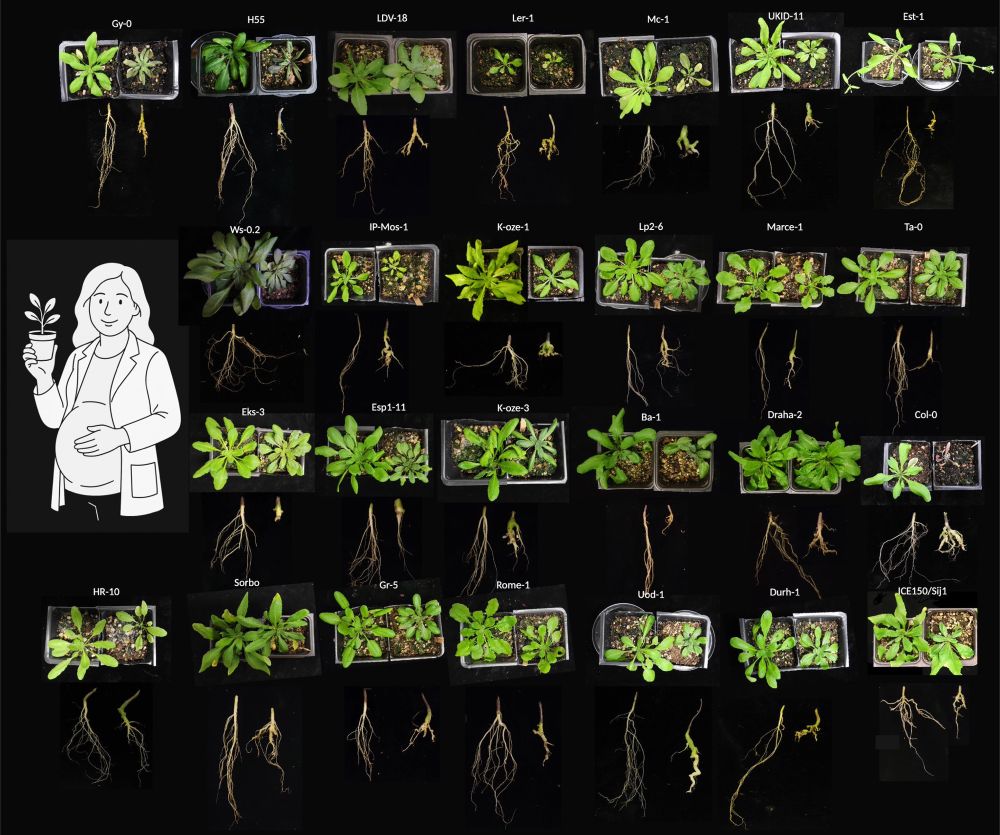
April 16, 2025 at 4:33 PM
🚨Preprint Alert!
Scooped by two other groups due to our lack of infrastructure to grow Arabidopsis, this study started in 2021, is still a great addition to the body of work looking for clubroot resistance in Arabidopsis! 💛
Link: doi.org/10.1101/2025...
Scooped by two other groups due to our lack of infrastructure to grow Arabidopsis, this study started in 2021, is still a great addition to the body of work looking for clubroot resistance in Arabidopsis! 💛
Link: doi.org/10.1101/2025...
Reposted by Sagar Bashyal
Great paper on CLE peptides in AM symbiosis from @sagarbashyal.bsky.social, @lmueller.bsky.social and colleagues -> A plant CLE peptide and its fungal mimic promote arbuscular mycorrhizal symbiosis via CRN-mediated ROS suppression
A plant CLE peptide and its fungal mimic promote arbuscular mycorrhizal symbiosis via CRN-mediated ROS suppression
CLAVATA3/EMBRYO SURROUNDING REGION-related (CLE) peptides have emerged as key regulators of plant–microbe interactions, including arbuscular mycorrhizal (AM) symbiosis. Here, we identify Medicago truncatula CLE16 as a positive regulator of AM symbiosis. MtCLE16 is expressed in root cells colonized by AM fungi (AMF) and its overexpression within colonized tissues increases arbuscule abundance by finetuning their growth and lifespan. Functional and transcriptomic analyses reveal that MtCLE16 acts via the M. truncatula pseudokinase CORYNE (MtCRN) and suppresses the accumulation of reactive oxygen species (ROS) in roots, thereby attenuating immune responses and promoting root colonization by mutualistic AM fungi. Notably, AMF also express MtCLE16-like peptides. We show that the Rhizophagus irregularis MtCLE16-like peptide, RiCLE1, also attenuates ROS and promotes AMF colonization via MtCRN. This finding suggests that RiCLE1 can interfere with the MtCLE16-MtCRN signaling module of host roots to benefit the fungus. Our research uncovers a functional mechanism underpinning cross-kingdom signaling and molecular mimicry in mutualistic plant–microbe interactions.
www.pnas.org
April 16, 2025 at 6:30 PM
Great paper on CLE peptides in AM symbiosis from @sagarbashyal.bsky.social, @lmueller.bsky.social and colleagues -> A plant CLE peptide and its fungal mimic promote arbuscular mycorrhizal symbiosis via CRN-mediated ROS suppression
Reposted by Sagar Bashyal
Reposted by Sagar Bashyal
📜 A plant CLE peptide and its fungal mimic promote arbuscular mycorrhizal symbiosis via CRN- mediated ROS suppression
🧑🔬 @sagarbashyal.bsky.social, @lmueller.bsky.social, et al.
📔 @pnas.org
🔗 pnas.org/doi/10.1073/...
#️⃣ #PlantScience #PlantSymbiosis #PlantDevelopment #PlantMycorrhiza
🧑🔬 @sagarbashyal.bsky.social, @lmueller.bsky.social, et al.
📔 @pnas.org
🔗 pnas.org/doi/10.1073/...
#️⃣ #PlantScience #PlantSymbiosis #PlantDevelopment #PlantMycorrhiza
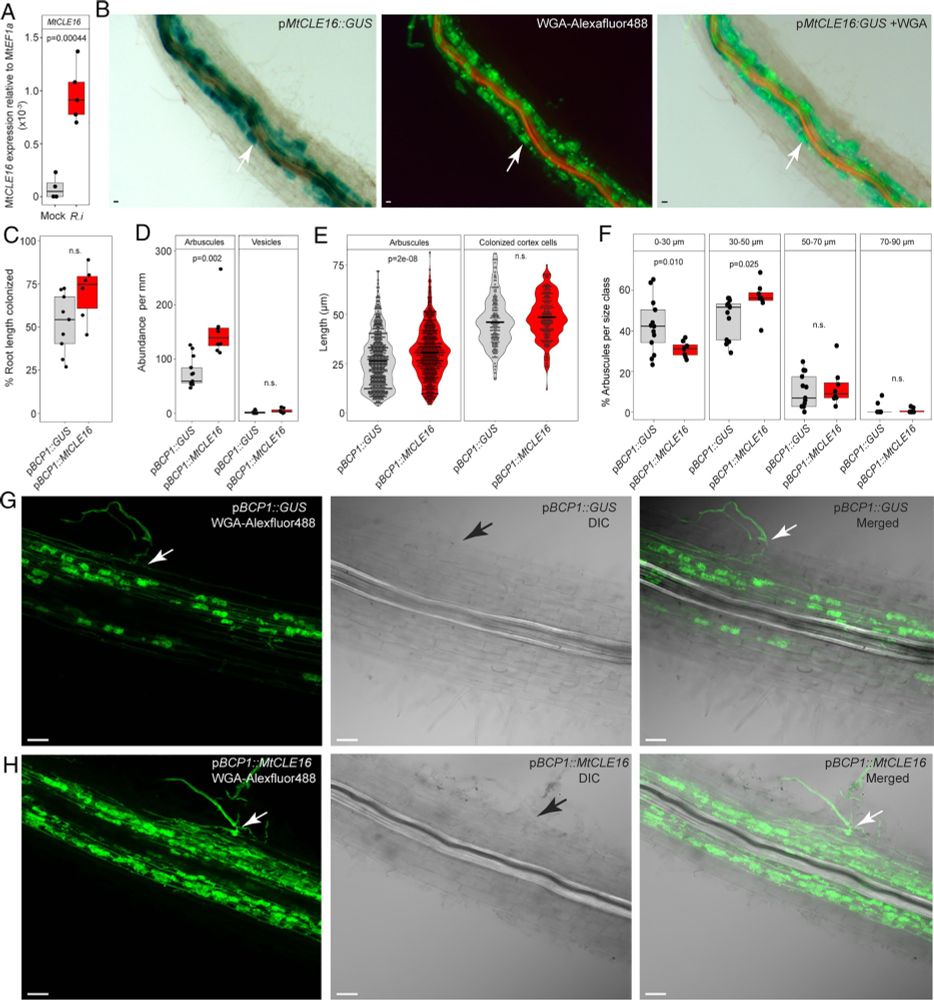
A plant CLE peptide and its fungal mimic promote arbuscular mycorrhizal symbiosis via CRN-mediated ROS suppression | PNAS
CLAVATA3/EMBRYO SURROUNDING REGION-related (CLE) peptides have emerged as key regulators
of plant–microbe interactions, including arbuscular mycorr...
pnas.org
April 16, 2025 at 7:34 AM
📜 A plant CLE peptide and its fungal mimic promote arbuscular mycorrhizal symbiosis via CRN- mediated ROS suppression
🧑🔬 @sagarbashyal.bsky.social, @lmueller.bsky.social, et al.
📔 @pnas.org
🔗 pnas.org/doi/10.1073/...
#️⃣ #PlantScience #PlantSymbiosis #PlantDevelopment #PlantMycorrhiza
🧑🔬 @sagarbashyal.bsky.social, @lmueller.bsky.social, et al.
📔 @pnas.org
🔗 pnas.org/doi/10.1073/...
#️⃣ #PlantScience #PlantSymbiosis #PlantDevelopment #PlantMycorrhiza


